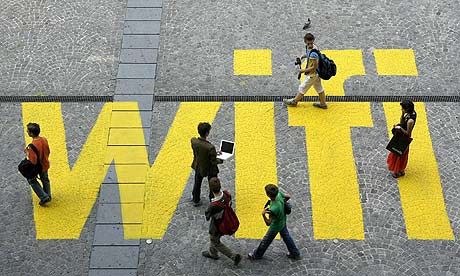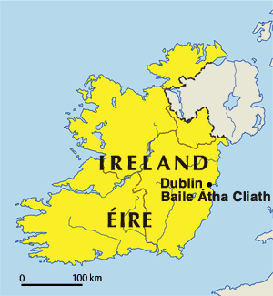Air pollution is such in London that drastic measures would be required before 'greenest ever Games' to avoid £175m fine
• Toxic waste clean-up on Olympic site cost taxpayers £12.7m
• Toxic waste clean-up on Olympic site cost taxpayers £12.7m
Even a 30% reduction in normal traffic during the Olympics would not bring emissions down to a legal limit, a report has said. Photograph: Dan Kitwood/Getty Images
Britain could be fined up to £175m by the International Olympic Committee if it continues to break air pollution laws by the time the Games begin next August.
The prospect of the air pollution penalty is becoming a major source of embarrassment to the government and Olympic organisers who set a goal of making the Games "the greenest ever" but have already watered down green measures planned for the event.
To meet the legally binding agreement, London may have to reduce traffic levels by more than 30% over a period of nearly a month, raising the possibility of draconian measures such as banning cars with number plates ending in odd and even numbers on alternate days.
Under the non-negotiable host city contract with the IOC – signed by the government and the mayor of London in 2005 – the IOC can withhold 25% of the expected £700m broadcasting income generated from the Games should air quality levels exceed EU limits during the games.
The contract has been given a temporary extension until later this year by the EU for the reduction of levels of small particulate matter (PM10), but has so far failed to find a way to do so and London risks a £300m fine from the European commission later this year.
London is one of the most polluted cities in Europe, with official studies showing that air pollution – mainly from traffic – causes more premature deaths than passive smoking and traffic accidents combined, at a cost of about £2bn a year.According to the Olympic Delivery Authority's Strategic Environmental Assessment (SEA), published this week, the expected increases in traffic along the Olympic route network of 600km of London roads during the Games will lead to further breaches of European legal limits in areas that already suffer from poor air quality.
Even a 30% reduction in normal traffic during the period of the Olympics may not be enough to bring emissions below the legal limit, it said.
Lawyers said London now has few options left beyond actions such as imposing an odd and even number plate ban throughout the city to enable endurance events, such as the marathon, to take place.
To read more, click here: London Olympics pollution
The panel's pledges ... and the reality
Air qualityPledge: London signed up to the Olympic host contract which specifies that the city must meet international pollution laws.
Reality: Olympic route will impact heavily on air quality making London more likely to breach laws unless it bans 30% of all cars.
Construction
Pledge: 90% of demolition materials to be reused or recycled, half of all materials to be brought in by rail and local waterways and at least 20% of recycled material to be used to build permanent venues and the Olympic village.
Reality: 95% of the buildings and infrastructure on the Olympic site was crushed and melted, but only around 1% reused. £20m was spent restoring a canal to ship 12,000 tonnes of waste and building materials a week, but only 3,000 tonnes were shipped on them in the first two years.
Athletes' village
Pledge: To make the village of 8,000+ homes energy self-sufficient.
Reality: Numbers reduced to 4,700 and homes built to Level 4 – good for UK but not the best possible.
Waste
Pledge: To achieve a 'zero-waste' games by reducing waste, recycling and sending nothing to landfill.
Reality: Plans watered down. Some food waste to be sent to landfill in Bedfordshire, 30% to be incinerated. No catalysation of nearby authorities to improve waste policies.
Energy use
Pledge: To generate 20% of energy on site from renewables.
Reality: The Olympic park to only produce 9% of its post-games energy from renewables. About 1,000 homes in surrounding areas to be insulated. Plans for wind turbines in Hackney and at Eton manor abandoned.
Olympic flame
Pledge: A low-carbon Olympic flame and torch.
Reality: EDF energy announcement expected soon.
Decontamination
Pledge: The site was heavily contaminated and 2.5sq km of contaminated land and 1.4m tonnes of soil had to be cleaned or remediated.
Reality: Independent assessors argue that more than 7,000 tonnes of radioactively contaminated material dumped in a former landfill site has been buried.
Wildlife/Park
Pledge: To create Europe's largest urban park.
Reality: 300,000 wetland plants grown in Norfolk and Wales. Almost 2,000 newts and hundreds of toads plucked from the site's wetlands and waterways. But anger in Greenwich where hundreds of trees will be affected, and the park closed for several months. Future problems could include erosion of park to make way for more housing.
Food
Pledge: To serve "the best of British" food.
Reality: Cadbury, McDonald's and Coca-Cola are the main sponsors, but millions of meals will be prepared by caterers. Hopes that all food would be organic, British and Fairtrade have been watered down. Dutch brewer Heineken have "pouring rights", which means no branded British ale will be sold on the 40 sites.
Carbon footprint
Pledge: To encourage visitors to come by train.
Reality: Event tickets to include London Underground travelcard.





